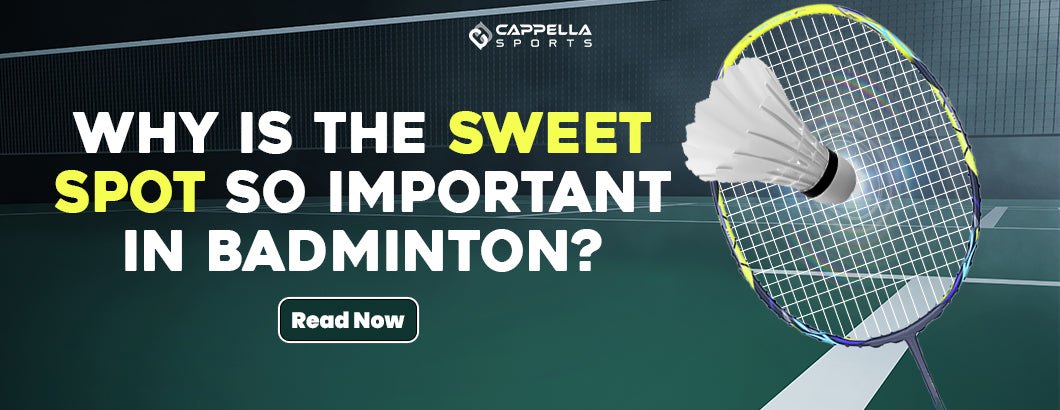Hitting the sweet spot on a badminton racquet isn’t just about delivering powerful shots - it’s about striking the perfect balance of precision, control, and consistency. For beginners, consistently connecting with the sweet spot can seem elusive and frustrating. But as your technique improves through practice and patience, hitting that perfect zone becomes instinctive.
Professional players make it look effortless, effortlessly delivering each stroke with finesse and minimal error. So, what’s their secret? Let’s break it down step by step.
Professional players make it look effortless, effortlessly delivering each stroke with finesse and minimal error. So, what’s their secret?
What Is the Sweet Spot in Badminton?
The sweet spot is the most responsive zone on the racquet’s string bed. When you strike the shuttlecock at this point, you generate maximum power with minimum vibration, resulting in a smooth, crisp, and controlled shot.
Think of it like the springiest area of a trampoline. Hit too far off-center, and the power diminishes. Hit it just right, and the shuttle soars with precision.
Where Exactly Is the Sweet Spot Located?
The sweet spot is typically found in the upper- middle area of the racquet head, slightly above the geometric center. In isometric racquets - common in modern high-performance models - the sweet spot is expanded vertically and horizontally to provide a larger, more forgiving zone for impact.
To feel it for yourself:
-
Gently drop a shuttle onto the strings from a short height.
-
Notice how the racquet responds.
-
A clean, solid feeling indicates you’ve hit the sweet spot.
What Factors Affect the Sweet Spot?
Several factors can influence the size and feel of your racquet’s sweet spot:
1. Racquet Head Shape
-
Oval Head: Smaller sweet spot, requiring more precise contact. Common in traditional or beginner racquets.
-
Isometric Head: Larger sweet spot, better forgiveness on off-center hits. Preferred by most professionals and advanced players.
2. Materials and Technology
Modern racquets use a variety of technologies to enhance performance:
-
Stiff carbon fiber frames: Offer quick energy transfer and sharp feedback.
-
Flexible shafts and frames: Allow more surface contact and are easier on the arm, increasing the margin for error.
3. String Tension
-
High Tension (34–36 lbs): Smaller sweet spot, more control and feedback, but punishes off-center hits.
-
Low Tension (24–26 lbs): Larger sweet spot, better shock absorption and power, ideal for beginners.
Tip: Beginners should stick to lower tensions to reduce mishits and improve durability.
How to Hit the Sweet Spot Consistently
Knowing where the sweet spot is won't help unless you train your body to naturally find it. This requires refined timing, muscle memory, and a relaxed, smooth swing. Below are three effective drills that will help you hit that perfect zone more regularly.
1. Half-Court Midcourt Clears
Objective: Improve shot technique with controlled swings.
-
Stand on one side of the court and hit clears just to midcourt.
-
Focus on clean contact and correct form rather than power.
-
As your consistency improves, gradually extend the distance of your clears.
This drill allows you to develop rhythm, accuracy, and feel. Once you're hitting the sweet spot regularly, you’ll notice your power naturally improving without forcing the shot.
2. Wall Drill Practice
Objective: Build reaction speed and improve hand-eye coordination.
-
Stand 5 - 8 feet away from a wall and hit the shuttle repeatedly.
-
Use both overhead and defensive strokes.
-
If the wall is uneven (like brick), the shuttle may bounce back unpredictably - making it excellent for training reflexes and control.
This drill enhances your adaptability, helping you manage off-center hits and build confidence in your ability to correct mid-rally.
3. Hanging Shuttle Drill
Objective: Focus on precision and stroke mechanics.
-
Suspend a shuttle from the ceiling or a rod using a thin string or fishing line.
-
Practice hitting the hanging shuttle using a variety of strokes (smashes, lifts, drops).
-
Since the shuttle isn’t moving, you can focus entirely on your swing technique, timing, and contact point.
This static drill isolates key elements of your technique, allowing you to make small refinements that pay off in live play.
Mastering the sweet spot is a journey. It starts with conscious effort - understanding the racquet, practicing drills, and correcting your technique. Over time, it transforms into a reflex. Your body learns the exact motion needed, and your mind no longer has to think about where to hit - it just does.
So whether you’re a beginner struggling with consistency or an intermediate player aiming to level up, remember: practice with intent, and the sweet spot will follow.

